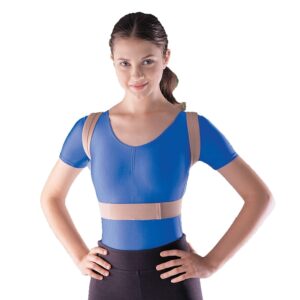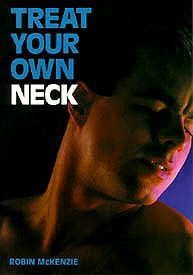Costovertebral Joint Sprain
Updated:
(Also known as Sprained Costovertebral Joint, Costovertebral Joint Dysfunction, Costovertebral Joint Injury, CV Joint Sprain)
What is a costovertebral joint sprain?
A costovertebral joint sprain is a condition characterized by damage or tearing of the connective tissue (such as ligaments, cartilage and joint capsule) of one of the costovertebral joints of the upper back.
The spine comprises of many bones known as vertebrae. Each vertebra connects with the vertebra above and below via two types of joints: the facet joints on either side of the spine and the discs centrally (figure 1). These joints are designed to support body weight and enable spinal movement. Each vertebrae in the upper back (thoracic spine) also connects to each rib via the costovertebral joint on either side of the spine (figure 2).
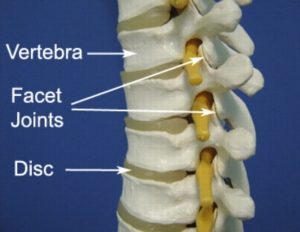

Each costovertebral joint comprises of smooth cartilage which lies between the bony joint surfaces cushioning the impact of one bone (the rib) on another (the vertebrae) during activity. Strong connective tissue also wraps around the bony ends providing support to the joint.
During certain movements of the rib cage and spine, stretching or compressive forces are placed on the costovertebral joints. If these forces are excessive, too repetitive or prolonged and beyond what the joint can withstand, injury to the costovertebral joint may occur. This may involve damage to the cartilage or tearing to the connective tissue surrounding the joint. This condition is known as a costovertebral joint sprain.
Causes of a costovertebral joint sprain
Costovertebral joint sprains typically occur during excessive bending (i.e. forwards, backwards or sideways), lifting, or twisting movements. They may occur traumatically or due to repetitive or prolonged forces. They may also occur due to being in poor posture (figure 3) for prolonged periods of time (e.g. sitting slouched, particularly whilst using a computer, driving or relaxing, or, sleeping in the foetal position). Costovertebral joint sprains may also occur due to repetitive or prolonged work with the arms in front of the body (e.g. house work, gardening or manual work) particularly in poor posture. In some cases, excessive coughing, sneezing or laughing may contribute to the development of the condition.
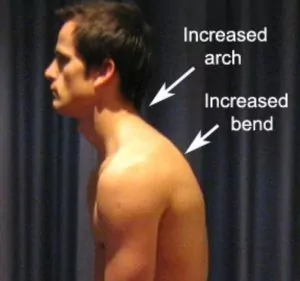
Signs and symptoms of a costovertebral joint sprain
Patients with a costovertebral joint sprain may experience a sudden onset of upper back and / or rib pain during the causative activity. However, it is also common for patients to experience pain and stiffness after the provocative activity (with rest), particularly the next morning. Symptoms are typically felt on one side of the spine and rib cage and muscle spasm may be experienced around the affected joint. Occasionally pain may be referred along the rib, into the chest, into the shoulder blade or sometimes the upper limb. Symptoms may be exacerbated during coughing, sneezing, laughing or deep breathing or with activities that involve twisting, lifting or bending (i.e. forwards, backwards or sideways). Patients with this condition typically experience tenderness on palpation of the affected costovertebral joint and / or rib and sometimes restricted movement in the upper back.
Diagnosis of a costovertebral joint sprain
A thorough subjective and objective examination from a physiotherapist is usually sufficient to diagnose a costovertebral joint sprain. Investigations such as an MRI or CT scan may be required to confirm diagnosis and rule out other conditions.
Treatment for a costovertebral joint sprain

Members Only ContentBecome a PhysioAdvisor Member to gain full access to this exclusive content. For more details see Become a Member. Already a member? Login Now
Prognosis of a costovertebral joint sprain
The recovery time for a costovertebral joint sprain may vary from patient to patient depending on compliance with physiotherapy. With ideal treatment, patients may be pain free in as little as several days, although typically this may take 2 – 3 weeks. It is important to note, however, that injured tissue takes approximately six weeks to restore the majority of its strength in ideal healing conditions. Care must therefore be taken when returning to activity during this period to prevent injury recurrence.
Physiotherapy for a costovertebral joint sprain

Members Only ContentBecome a PhysioAdvisor Member to gain full access to this exclusive content. For more details see Become a Member. Already a member? Login Now
Contributing factors to the development of a costovertebral joint sprain

Members Only ContentBecome a PhysioAdvisor Member to gain full access to this exclusive content. For more details see Become a Member. Already a member? Login Now
Other intervention for a costovertebral joint sprain
Despite appropriate physiotherapy management, a small percentage of patients with this condition fail to improve and may require other intervention. This may include pharmaceutical intervention, corticosteroid injection, investigations such as an X-ray, CT scan or MRI, or assessment from a specialist. The treating physiotherapist can advise on appropriate management and can refer to the appropriate medical authority if it is warranted clinically.
Exercises for a costovertebral joint sprain
The following exercises are commonly prescribed to patients with a costovertebral joint sprain. You should discuss the suitability of these exercises with your physiotherapist prior to beginning them. Generally, they should be performed once the physiotherapist has indicated it is safe to do so and only provided they do not cause or increase symptoms.
Your physiotherapist can advise when it is appropriate to begin the initial exercises and eventually progress to the intermediate, advanced and other exercises. As a general rule, addition of exercises or progression to more advanced exercises should take place provided there is no increase in symptoms.
Initial Exercises
Shoulder Blade Squeezes
Begin sitting or standing tall with your back and neck straight (figure 4). Squeeze your shoulder blades together as far as you can go without pain and provided you feel no more than a mild to moderate stretch. Hold for 1-2 seconds and repeat 10 times provided there is no increase in symptoms. Perform 3 – 5 times per day.

Rotation in Sitting
Begin sitting tall, with your back and neck straight and your arms across your chest. Keeping your legs still, gently rotate to one side as far as you can go without pain and provided you feel no more than a mild to moderate stretch (figure 5). Repeat 10 times to each side, alternating sides, provided the exercise is pain free. Perform 3 times per day
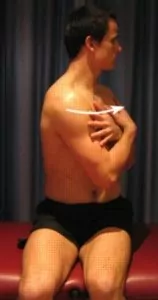
Intermediate Exercises

Members Only ContentBecome a PhysioAdvisor Member to gain full access to this exclusive content. For more details see Become a Member. Already a member? Login Now
Advanced Exercises

Members Only ContentBecome a PhysioAdvisor Member to gain full access to this exclusive content. For more details see Become a Member. Already a member? Login Now
Other Exercises

Members Only ContentBecome a PhysioAdvisor Member to gain full access to this exclusive content. For more details see Become a Member. Already a member? Login Now
Rehabilitation Protocol for a costovertebral joint sprain

Members Only ContentBecome a PhysioAdvisor Member to gain full access to this exclusive content. For more details see Become a Member. Already a member? Login Now
 Physiotherapy Products for a costovertebral joint sprain
Physiotherapy Products for a costovertebral joint sprain
Some of the most commonly recommended products by physiotherapists to hasten healing and speed recovery in patients with this condition include:
To purchase physiotherapy products for a costovertebral joint sprain click on one of the above links or visit the PhysioAdvisor Shop.
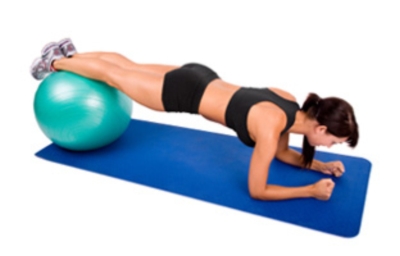 More Exercises
More Exercises
- Postural Exercises.
- Upper Back Flexibility Exercises.
- Upper Back Strengthening Exercises.
- Core Stability Exercises.
- Scapular Stability Exercises.
- Beginner Pilates Exercises.
- Gym Cable Exercises (Back and Biceps Workout).
- Cardiovascular Exercise.
 Recommended Reading
Recommended Reading
- Correct Posture.
- Postural Taping.
- Mobile Phone Ergonomics.
- Ergonomic Computer Setup.
- Bike Setup.
- Choosing a School Bag.
- Correct Lifting.
- Ice or Heat.
- Investigations.
- The R.I.C.E. Regime.
- Warming Up and Cooling Down.
- Return to Sport.
- Upper Back & Chest Diagnosis Guide.
 Find a Physio for a costovertebral joint sprain
Find a Physio for a costovertebral joint sprain
Find a physiotherapist in your local area who can treat a costovertebral joint sprain.
Become a PhysioAdvisor Member
-
 Individual Membership (12 Months)$59.95 for 1 year
Individual Membership (12 Months)$59.95 for 1 year -
 Individual Membership (3 Months)$39.95 for 3 months
Individual Membership (3 Months)$39.95 for 3 months -
 Individual Membership (Yearly)$49.95 / year
Individual Membership (Yearly)$49.95 / year -
 Individual Membership (Monthly)$15.95 / month
Individual Membership (Monthly)$15.95 / month

Link to this Page
If you would like to link to this article on your website, simply copy the code below and add it to your page:
<a href="https://physioadvisor.com.au/injuries/upper-back-chest/costovertebral-joint-sprain”>Costovertebral Joint Sprain – PhysioAdvisor.com</a><br/>PhysioAdvisor offers detailed physiotherapy information on a costovertebral joint sprain including: causes, symptoms, diagnosis, treatment, exercises, rehabilitation protocol, physiotherapy products and more...
Return to the top of Costovertebral Joint Sprain.

